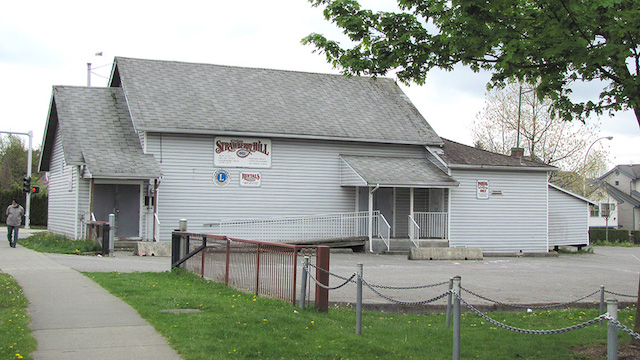How Strawberry Hill Got Its Name
When I was growing up in Surrey, Strawberry Hill meant hitting up the Starbucks in Chapters for one of those new Frappuccinos or catching the Lord of the Rings Trilogy at the movie theatre. Located along the Delta border in Surrey’s Newton neighbourhood, the Strawberry Hill area was indeed a place where strawberries once grew. It’s also a community that was impacted by the Japanese Canadian Internment during the Second World War.
How Strawberry Hill Got Its Name
Japanese Canadians began growing strawberries in the area at the turn of the last century, cultivating spots between stumps of old growth forest. The berries were sent to canneries in New Westminster and Vancouver and were an integral part of early trade in Metro Vancouver.
From Heritage BC: “The origins of the Strawberry Hill community are deeply tied to local Japanese Canadian families who moved to the area and began farming in the early 1900s, greatly impacting the neighbourhood’s formation through community and agricultural projects. Japanese Canadians financially supported the creation of Strawberry Hill’s community hall and the formation of 72nd Avenue in the first half of the twentieth century. Their efforts dramatically impacted Surrey’s agricultural landscape, making berry growing a thriving industry prior to 1940.
Japanese Canadian families were responsible for the creation of the Surrey Berry Growers’ Co-operative Association and the Strawberry Hill Japanese Farmers’ Association. Like many communities, Strawberry Hill supported a Japanese Language School which had a student population of 44 in 1934.
Strawberry Hill holds national, cultural and social value in Surrey’s heritage. It is the location of one of the only tracts of Japanese-Canadian owned land that was seized by the Government of Canada in 1942 and returned to the owner, Zennosuke Inouye, a Japanese-Canadian veteran, following World War II.”
Today, the Strawberry Hill Farmers Institute Hall (12152-75 Ave), now Strawberry Hill Hall, stands as a reminder of this heritage, and is Surrey’s oldest community hall. It was built in 1909 with constructed with the help of donations, grants and volunteer labour on land donated by the first president of the Institute, George Henry Flux.
More Resources
You can read a transcript of material that formed the basis of a 2012 interview with Mrs. May Brown [Strawberry Hill, British Columbia: A New Perspective On the 1942 Evacuation] about her time in Strawberry Hill before and after WWII and the Internment of Japanese Canadians. Amelia Adam’s Park (between 84th and 86th Ave near Scott Road) is named after her mother.
In the summer of 2019, the Surrey Art Gallery hosted an exhibition by Cindy Mochizuki featuring the history of Japanese-Canadian berry farmers in the region. Autumn Strawberry was in the gallery’s Tech Lab from June to August.
Mochizuki told the Surrey Now Leader: “During the internment, the Japanese Canadians weren’t allowed to take photographs. Because there were no images, I’m interested in making those images. I want to make visible what is not visible in history.”
Also in the summer of 2019 an open house was hosted to propose conservation renovations to the Strawberry Hill Hall which now sits on the corner of 75th and 121st, at the edge of R.A. Nicolson Park. According to City of Surrey documents, an Invitation to Tender (ITT) went out in March, 2020 and the project should be moving forward in April, 2020, with work happening May to September of 2020.
As someone who grew up in Surrey and who loves researching local history, I had no idea about any of this until I started drafting this post a few months ago. It’s been enlightening and heartbreaking. Hopefully when we’re all able to travel around again (after COVID19 isolation) the Hall will be fully restored — and perhaps even be on a Surrey Doors Open tour — so the history can be even more widely shared.












4 Comments — Comments Are Closed
Thanks for this post! I also did not know about this history. I had no idea that there was a Japanese community there since my family was in Kitsilano. One thing though, ‘interment’ is for ashes. I think you meant to use ‘internment’ in your first paragraph.
I grew up across Scott Road from the Strawberry Hill area and well remember the old Strawberry Hill Annex elementary school and the old dilapidated farm houses that were there before the big box stores and theatre moved into the area in the 90s. I had no idea this was traditionally an area with a Japanese Canadian history even though I’m a social studies teacher with a Japanese wife and ties to Vancouver’s Nikkei community. Thanks so much for the post.
To Gord who commented on Thurs. April 16.
I wonder if you remember any family names when growing up in Strawberry Hill.
I believe my parents lived in Strawberry Hill. I understand they had a strawberry farm.
Might you recall Fukushima or Imahashi
Thank you
Sorry Hideo, but I don’t recall either of those names. I was across Scott Road in Delta so the kids in Strawberry Hill would have gone to a different school. My best friend in high school was a Kato but they had moved into the area in the 70s.
I just found out about the Strawberry Hill Japanese School. It was listed on a register of all the Japanese language schools in British Columbia in 1934 that was included in a presentation on the history of the Japanese Hall in Vancouver.
https://www.youtube.com/watch?v=YvjM5yOLwPs
The image is shown at the 18:24 mark. At the time the school had 44 students and 2 teachers and was teaching twice a week. The subjects taught were reading, writing and composition. That is quite a number of kids for such a small area. I wonder if it was still running when your folks were living there.